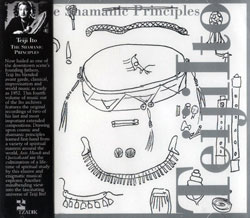
Touted by some as the father of NY's downtown scene, Teiji Ito's recorded legacy reaches back as far as 1952. This disc is the fourth offering in Tzadik's series from Ito's private collection. Known primarily as a composer for film and dance, much of his work involved the melding of non-western ideas and sounds with western musical forms. He also studied shamanism and once took part in a Sioux Indian sun dance, both of which informed the works presented here, which are among the last pieces he recorded. (Ito passed away in 1986).
Sonically, I find "Axis Mundi", the first of these two pieces more interesting, and it definitely sounds similar to recordings of shamanic rituals i have heard, a kind of ur-music based in the idea of a universal consciousness. The sounds of stones, rattles, bone flutes and voices played by Ito and two "accompanists" — Genji Ito and Dan Erkkila — conjure images of night huts and stone-age gatherings. The sounds themselves are quite interesting, particularly the massed flutes improvising amid clashing harmonics. Reproductions of pages from the score are provided in the booklet, and these are interesting to ponder, if not completely enlightening. An equally interesting earlier recording, made by Ito multi-tracking himself, is alluded to as well.
"Quetzalcoatl", the second piece, I find less satisfactory, as it's constructed around a narrative read aloud by someone whose name is given only as Diane. The piece brings together American Indian and Asian musics, but doesn't so much mix them as place them alongside each other in support of the story. I was surprised to read that Ito and his friends played all the instruments, as the Indian songs sound completely authentic- perhaps a testament to Ito's sincerity. In between the Indian songs and the narrative are bits that come closer to combining cultures, sometimes sounding a bit like gagaku or even the Art Ensemble of Chicago. I'd love to hear more of this kind of cross-pollination.
Immersing myself in these recordings brought up a lot of questions for me. I've long been interested in shamanism myself, and knowing what I do about it I wonder what purpose recordings like these serve. If the efficacy of a shaman is in his/her actions themselves, in front of you, of what use is a recording mimicking them? Is the healing power people speak of inherent in the sounds themselves, or in the larger participatory action? Many people have tried to bring together spiritual musics and the western tradition, but their efforts usually end up sounding like the clash of ideologies that they are. With these recordings, Ito at least maintained the feel and sound of authentic "primitive" musics.
Comments and Feedback:
|



